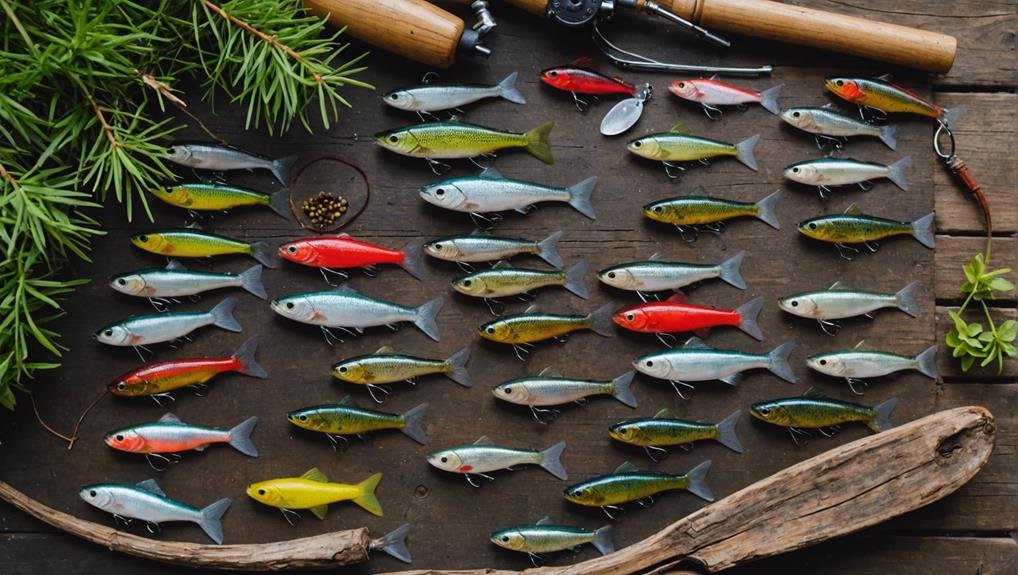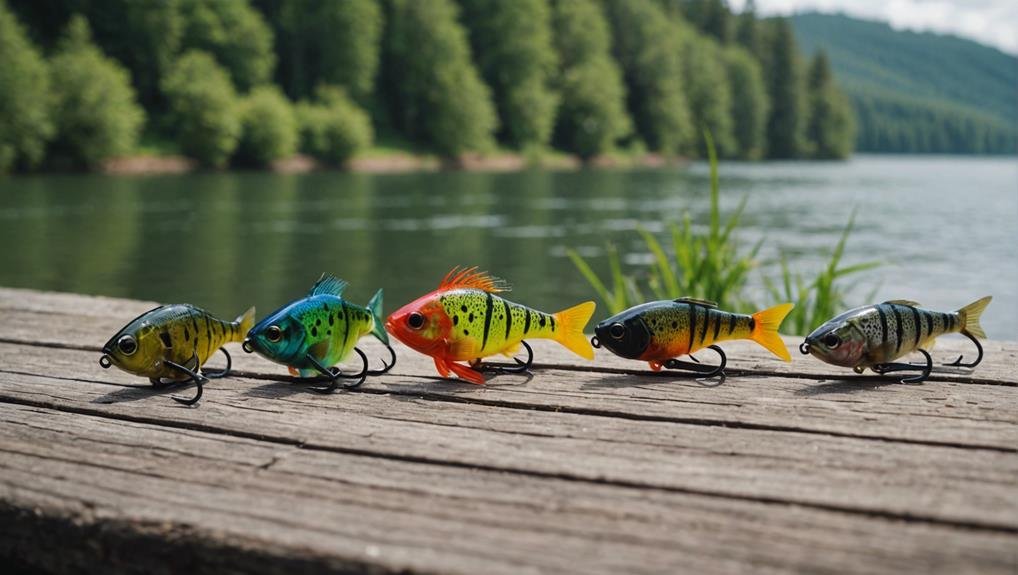When you’re out on the water, choosing the right trout lure can make all the difference between a successful catch and going home empty-handed. It’s not just about picking any lure; understanding trout behavior and their natural food sources is essential. Whether you’re considering dry flies like the Elk Hair Caddis for surface feeders or nymph flies like the Pheasant Tail for those lurking below, matching your lure to the environment is vital. But what about the best jigs, spinners, spoons, and soft plastics? Let’s explore how you can enhance your fishing strategy.
Key Takeaways
- Dry flies like Elk Hair Caddis are excellent for surface-feeding trout.
- Spinners like BlueFox Vibrax Bullet Fly are versatile and effective in various water conditions.
- Streamers like Woolly Bugger mimic small fish and attract aggressive trout.
- Jigs, including Trout Magnet and Berkley PowerBait Pre-Rigged Atomic Teaser Jig, work well in clear, murky waters.
- Soft plastics imitate natural food sources and are highly versatile in color and size.
Understanding Trout Behavior

To catch more trout, you need to understand how their behavior is influenced by food availability, water temperature, and oxygen levels. Trout behavior can drastically change based on these environmental conditions, making adapting your approach essential for a successful fishing trip.
Trout are known to be either aggressive or cautious, depending on their surroundings. When food sources are abundant, trout may become more selective, ignoring certain lures for trout that don’t closely mimic their natural prey. Conversely, when food is scarce, they tend to be less picky, increasing your chances of a strike regardless of the lure type.
Water temperature is another key factor that affects trout behavior. Trout thrive in cooler waters, typically between 50-60°F. When temperatures rise above this range, their activity levels can decrease, making them harder to catch. In colder waters, trout are more active and likely to pursue their lures more aggressively.
Understanding these behavioral nuances can help you make better decisions when choosing lures for trout. You’ll increase your chances of landing that prized catch by tailoring your lure selection based on the specific conditions you’re fishing in.
Food Sources for Trout
Understanding what trout eat is key to selecting the right lure and increasing your chances of a successful catch. Trout feed on diverse food sources, including insects, crayfish, small fish, and even sculpins and small birds. Knowing what’s available in the body of water you’re fishing, you can choose Trout baits that closely mimic these natural prey items.
The food sources available to Trout can vary widely in creeks, rivers, and lakes. When food is abundant, Trout might focus on a single type of prey, making them more predictable. However, they become less selective during times of scarcity, offering you a broader range of effective Trout baits.
Analyzing the prevalent food sources in any given water body will help you understand Trout’s behavior and feeding habits. For instance, you might find Trout feeding aggressively on nymphs or adult insects in insect-rich streams. In contrast, in larger lakes, they might prefer small fish or crayfish. By imitating these food sources with your lures, you greatly increase your chances of catching Trout, tailoring your approach to their natural diet and environment.
Selecting the Right Lures

Choosing the right lure for trout fishing hinges on several key factors that can greatly influence your success. Start by considering the water conditions. Clear waters often call for more natural-looking lures, while murky waters might require something brighter and more noticeable.
Temperature also matters; warmer waters might make trout more active, changing their response to different lures. Different trout species have their preferences, so adjust your selection accordingly. For example, rainbow trout might go after a different lure than brown trout.
The time of day is vital, too. Dawn and dusk are prime times for trout fishing, and certain lures, like live bait, can be more effective during these periods. Water depth is another essential factor. Jig heads work well in deeper waters, while fly fishing might be more effective in shallow streams.
Always consider the natural food sources available to the trout in your area. Mimicking what they’re used to eating can significantly increase your chances of a bite. Whether using live bait, a jig head, or engaging in fly fishing, aligning your lure choice with these factors will enhance your trout fishing experience.
Best Flies for Trout
When selecting the best flies for trout, focusing on specific types like dry, nymph, and streamer flies can greatly improve your chances of success. Dry flies like Elk Hair Caddis or Adams are fantastic for surface-feeding trout, making them one of the best trout lures you can use. For underwater action, nymph flies such as Pheasant Tail and Hare’s Ear nymphs imitate insect larvae and are superb at attracting feeding trout.
Streamer flies are ideal if you’re after more aggressive species like Lake Trout or Brown Trout. Streamers mimic small fish or baitfish, enticing trout to strike. The Woolly Bugger is a versatile streamer that can imitate various aquatic creatures, making it a must-have in your tackle box.
Here’s a quick reference table to help you choose the right fly:
| Fly Type | Examples |
|---|---|
| Dry Flies | Elk Hair Caddis, Adams |
| Nymph Flies | Pheasant Tail, Hare’s Ear |
| Streamer Flies | Woolly Bugger |
Using the right fly can help you catch much more trout, whether targeting Brown Trout in rivers or Lake Trout in deeper waters. Stick to these proven patterns, and you’ll increase your chances of a successful fishing trip.
Top Jigs for Trout

For a successful trout fishing trip, jigs like the Trout Magnet and Berkley PowerBait Pre-Rigged Atomic Teaser Jig offer unmatched versatility and effectiveness. The Trout Magnet is a top choice for anglers looking to catch trout in various water conditions. Its unique design allows it to mimic the natural movement of prey, making it irresistible to trout. You’ll find it especially effective in both clear and murky waters.
The Berkley PowerBait Pre-Rigged Atomic Teaser Jig is another excellent option. Known for its pre-rigged convenience and powerful scent, it can attract trout from a distance, increasing your chances of a successful catch.
When fishing in different habitats, consider using Southern Pro Tiny Worms. These jigs are versatile and can adapt to various fishing environments, ensuring that you have the best chance to catch trout regardless of the water conditions.
Cubby Mini Mite Jigs are also well-regarded for their ability to mimic natural prey. Their lifelike presentation is ideal for enticing trout strikes.
Effective Spinners
After equipping yourself with the best jigs, it’s time to explore the effectiveness of spinners in your trout fishing arsenal. Spinners, especially inline spinners, are incredibly versatile and can help you cover a lot of water to find trout. The spinning action of these lures mimics the movement of prey, making them irresistible to trout and often triggering aggressive strikes.
Here are some reasons why spinners are a must-have:
- Versatility: Inline spinners can be cast, trolled, or retrieved in different water conditions, giving flexibility in your fishing approach.
- Effective Coverage: Spinners allow you to explore various depths and cover a lot of water efficiently, increasing your chances of locating trout.
- Attraction: The flash and vibration produced by the spinning blades are highly attractive to trout, provoking them to strike.
- Proven Success: Spinners like the BlueFox Vibrax Bullet Fly are well-known for their ability to trigger trout strikes with their effective design.
Using spinners, you can maximize your fishing time and catch rates. Whether casting in a stream or trolling in a lake, these lures will help you find trout and bring in a lot of fish.
Best Spoons for Trout

Spoons are essential to any trout angler’s tackle box due to their versatility and proven effectiveness. Whether you’re aiming for a catch-and-release session or hoping to hook big Trout, spoons offer a reliable option.
One of the top choices is the Thomas Lures Buoyant Spoon. This spoon excels in both trolling and casting presentations, making it a versatile tool for various water conditions. Its unique design attracts Trout by mimicking the movement of small fish, triggering those much-desired strikes.
Another excellent option to consider is the BlueFox Vibrax Bullet Fly. This spoon stands out with its spinning metal blades, which create a flash and vibration irresistible to Trout. The Blue Fox Vibrax Bullet Fly is particularly effective in murky waters where visibility is low, helping you effortlessly lure Trout to your bait.
When selecting spoons, consider the size, color, and action that best match the Trout’s feeding behavior in your area. Spoons’ flash and wobble make them a popular choice, capable of enticing Trout in various environments.
With the right spoon in your arsenal, you’re well on your way to a successful day on the water.
Using Soft Plastics
Switching gears from spoons, soft plastics like worms and crayfish models offer another dynamic option for targeting Trout in various water conditions. These lures excel at imitating natural food sources such as insects, small fish, and crustaceans, which Trout feed on regularly. You’ve probably caught a lot of Trout using these lures, and they work exceptionally well throughout the United States.
Soft plastics are incredibly versatile regarding color, size, and presentation. This flexibility allows you to adapt based on Trout’s behavior and preferences, making them a must-have in your tackle box. The best time to use these lures depends on water conditions and Trout activity levels.
Here are some tips for using soft plastics effectively:
- Experiment with Colors and Sizes: Different environments can make Trout picky, so having a variety of colors and sizes can help you find what works best.
- Rig Weedless or Exposed Hooks: This can prevent snags and increase hookup rates, especially in cover-rich areas.
- Match the Hatch: For better results, try mimicking the local food sources Trout are feeding on.
- Vary Your Retrieve: Sometimes, a slow, steady retrieve works well; other times, a more erratic action triggers bites.
Conclusion
You need to understand their behavior and food sources to catch more trout. Choose lures that mimic what they naturally eat.
Dry flies, nymphs, streamers, jigs, spinners, spoons, and soft plastics all have their place. Selecting the right lure for the conditions and trout species will boost your chances of success.
So, gear up with the best trout lures and head to the water. You’re ready to reel in some impressive catches!
FAQs
What are the top lures for catching trout?
Top lures for catching trout include spinners, spoons, and soft plastic baits. Popular options are Mepps Aglia Spinner, Panther Martin Spinner, Acme Kastmaster Spoon, and Berkley PowerBait Power Worms. These lures mimic trout’s natural prey and are highly effective in various water conditions.
How do spinners work in trout fishing?
Spinners create flashes and vibrations in the water, attracting trout to strike. The rotating blade on a spinner generates light reflections and movement that mimic small fish or insects, making them irresistible to trout. Retrieve the spinner at a steady pace to maintain its action.
When and where should I use soft plastic baits for trout?
Soft plastic baits are effective in rivers and lakes, particularly during warmer months when trout are more active. Use them near structures like rocks, weed beds, and drop-offs where trout often hide. Jigging or slowly retrieving soft plastics can entice strikes from wary trout.

